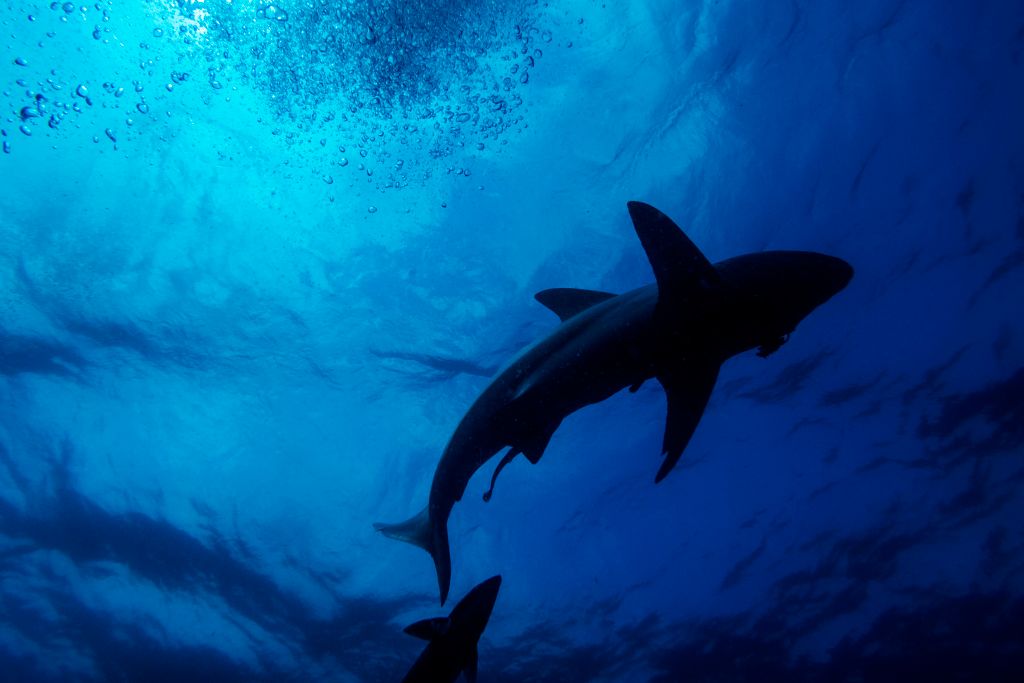The small South African coastal town of Umkomaas hosts many scuba diving operations and resorts; its local reef system, the Aliwal Shoal, is one of the top fifty dive sites in the world. It contains the usual attractions like schools of tropical fish, turtles, rays and a few shipwrecks. The real attraction though — the reason people come from all over the world to this sleepy town — is to dive with sharks. Without a cage. For up to sixty minutes at a time.
The Blue Ocean Dive Resort, where I stayed for a week, specializes in these dives, employing several experts to maximize the shark sightings. During my time there, I must have seen over fifty different sharks, including oceanic blacktips, bull sharks and tiger sharks.
The key to seeing so many sharks are the baited dives which almost guarantee sightings. A cylinder is filled with sardines and attached to a buoy that floats in the water. The boat drops the divers off and leaves the area. The sharks, of course, come to investigate the tank of sardines hanging about ten meters deep; they don’t notice the divers watching from a few meters away. This is different from what cage-dive operators in Cape Town do — it avoids the negatives of chumming the water, which makes sharks associate boats and humans with food.
The best time to dive with sharks is early in the morning as they are coming to the end of the feeding cycle. It means setting your alarm for 4:30 a.m., but the excitement usually meant I woke up a lot earlier anyway and couldn’t go back to sleep.
Before each dive, the guides give a detailed briefing on why it’s very unlikely you will be attacked by a shark. In these waters, there are no seals or mammals that are easy prey, so the sharks stick to fish. One guide even claimed that if you chopped your arm off in the water and were bleeding heavily, the sharks wouldn’t pay you any attention. It’s not an experiment I’d like to try myself, but it makes sense. Even when great whites swim up from areas like Cape Town they know there aren’t mammals in the water and their sensory systems automatically change.
As soon as the bait is in the water, we notice fins on the surface. It’s an incredible and exhilarating sight, especially as we’re about to jump in to join them. Once our gear is on, the captain counts down, we roll back into the water and start our descent. After a minute, we’re ten meters below the surface and sharks swim around us. It’s overwhelming to start, with so many of them, but after some time we relax and enjoy the show. The hour goes by quickly and soon the guides are signaling us to start our ascent to the boat. We’re on a high and spend the rest of the day unable to talk about anything other than how awesome sharks are. On one of my dives, another group saw a great white — I was almost in tears at having missed out.
Since the age of five I’ve been fascinated with sharks. My older and somewhat irresponsible cousin made me watch Jaws. I was scared at the time but wanted to watch it again and again. As I grew older, my fascination continued to grow as I watched shark documentaries and read anything I could about them in books and magazines.
Over the years I learned that shark attacks on humans are often a case of mistaken identity. Most attacks take place when a surfer is sitting on the board waiting for a wave. For a shark looking up from below, the silhouette looks exactly like a seal’s. The shark comes up to investigate, takes a bite and realizes it’s not their natural prey. There are very few occasions where someone has been eaten whole — normally the shark realizes humans aren’t food and swims away. Unfortunately the damage has been done and victims often bleed to death before they can get help.
Sharks have always been considered a threat to humans, yet so many of the myths are false. According to one, once a shark tastes human meat it will only want to eat humans. Another says that if you feel scared, the shark can sense your fear and is motivated to eat you. Some people think that sharks spend all their time looking for humans to eat because they have nothing better to do.
The statistics tell a different story. Each year, there are on average eighty shark attacks on humans worldwide, of which five are fatal. The chance of being killed by a shark is one in 3,748,067; you’re more likely to be killed by a dog, bee sting or lightning strike.
Studies on sharks tell us that they prefer to eat an easily obtained food, like fish. Even in areas where they eat mammals like seals, dolphins or whales, they do so because there is a lot of blubber and meat on them. Thankfully, humans don’t usually have much meat or blubber. Imagine going into a butcher’s, walking past all the wonderful beef on display and choosing to buy a thin scrawny rat — that’s what it would be like if a shark picked a human instead of a tasty seal.
I first learned to scuba dive while traveling through Southeast Asia with my wife. After we were qualified, I saw an ad at a dive resort in the Philippines to dive with thresher sharks. I was intrigued and convinced my wife to let me go (she first made sure my life insurance policy included diving accidents). We were sitting at the bottom of the reef on a sand bank when suddenly a huge shadow appeared in the distance — it was a thresher shark which circled us twice and then disappeared. Seeing a creature underwater that is bigger than you is an amazing experience. It reminds you of how big this world is and how small a part we play in it. I was instantly hooked.
There is a thrill to heading out to sea searching for these magnificent creatures. It’s like being on safari looking for a lion — the only difference is you’re underwater breathing air out of a tank. Sharks have been around since the age of the dinosaurs and are perfectly evolved for their needs: it’s always striking to me how easily they glide through the water, the smallest flick of their tails propelling them faster than we will ever be able to do.
My eldest daughter is now also fascinated by sharks. She spends a lot of time with me watching clips of people diving and swimming with sharks. Every year she asks me if she’s old enough to go shark diving with me. I tell her to ask her mother.
This article was originally published in The Spectator’s February 2024 World edition.


























Leave a Reply